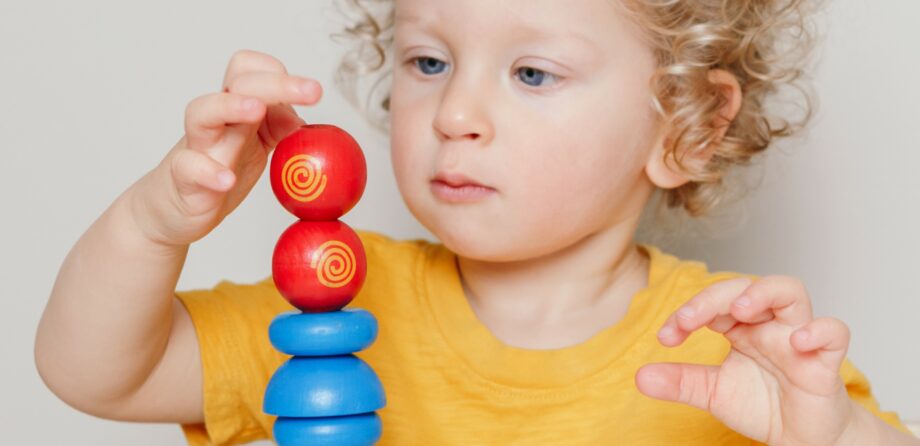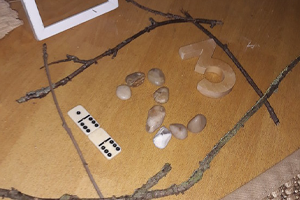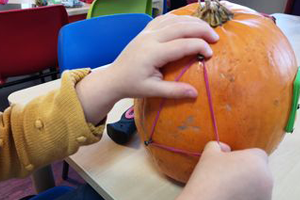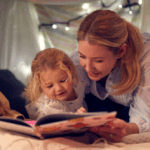
Why is maths important in early years?
Maths is important in early years as receiving a good foundation in maths is essential for life skills.
As well as developing numeracy (understanding and using numbers), it helps with skills such as problem-solving, understanding and using shapes and measures and developing spatial awareness.
Mathematical development in the EYFS helps children to recognise, create and describe patterns, which is valuable for problem-solving skills. Introducing maths to children from an early age helps to develop their understanding of all elements of problem-solving and reasoning in a broad range of contexts.
From construction play to maths development in a real-life context, and finding opportunities for development in your setting, see our top tips below.
Developing early years maths with construction play
Indoor and outdoor construction play provides an abundance of early years maths opportunities. Children can problem-solve in a fun and playful way using a range of manipulatives.
Construction play can help children learn early number sense, shape and space properties, patterns, measures, spatial awareness and mathematical language.
Recent research shows that, as well as developing early number sense, both pattern and spatial reasoning are predictors of children’s later maths attainment.
Construction materials
You play a key role in providing a variety of construction materials for children to play with, which can include: blocks, bricks, boxes and natural materials. Children will use purposely designed interlocking construction materials such as Lego and Duplo to fit shapes together and to make towers and simple structures.
Imagery
Include pictures of tower blocks and structures in your construction area so children can make direct comparisons, by copying structures and identifying similarities/differences in shape and size.
Children will then progress to make more complex models and enclosures, including larger scale construction outdoors such as den-making.
Using the whole body
Larger outdoor construction allows children to work together and problem-solve using their whole bodies.
Open-ended resources
Open-ended resources such as crates, planks, guttering, large cardboard boxes, tubes, wheels, tyres, tarpaulin, bamboo, dowelling and connecting materials such as large clips and string, provide excellent problem-solving resources for outdoor construction.
Mathematical language
Conversing with your children about their constructions can extend and challenge their mathematical thinking and learning. Ask children to describe their models, using consistent mathematical language such as ‘taller’ and ‘longer’. By observing and discussing the strategies they use to count, compare, estimate and problem-solve, you can gain an insight into their thought processes and reasoning, and can then pose occasional challenges.

Outdoor counting games
Children can count spontaneously from an early age by saying some number names and often saying numbers in the wrong order. They need many experiences and opportunities with numbers and counting in order to consistently develop their ability to count.
Children must learn ‘number names’, ‘one-to-one correspondence, ‘stable order’, ‘how many altogether’ and ‘which number comes next’ counting principles consistently, in order to count successfully.
Playing games with adults – such as you or their parents – is a great way to help children learn the correct counting order. A major advantage of outdoor counting games is that they often do not require expensive resources, just time, collections of everyday objects, imagination and mark-marking resources such as large chalks.
Children benefit more from practical experiences that use mathematics for a purpose than from abstract formal learning (Gelman, 2006)
As a practitioner, you should introduce a small number of games initially and spend a long time modelling and playing with children, supporting the development of number sense. Provide lots of opportunities for children to record numbers and scores outdoors using chalk, on clipboards, whiteboards or with moveable counters. As children become more familiar with the game and more confident, they can begin to use their own ideas and their knowledge to develop their own games.
Target games
Target games are a great way to support numbers and counting. Provide chalked out targets, cardboard boxes, hula hoops or buckets for children to aim for. Each time a child scores a point this could be recorded on a chart or each child could have their own pot where they put a counter each time they score, and then these can be counted up at the end to see who has the most and is the winner.
Labelling
Labelling targets with different numbers, for example, five cardboard boxes labelled one to five, helps develop children’s number recognition. Ask children to aim for number three. As their number sense increases so can the challenge, by arranging the boxes in random order or asking them to aim for one and three, and asking how many this makes altogether (cardinality).
Track games
Track games allow children to physically move themselves along so they get a ‘feeling’ of numbers. Drawing or marking out a track and using dice or spinners with numerals can create a fun game for children to engage in, by moving along a track. As children become more confident with numbers these can be changed to dotty dice to support their ability to subitise (recognise the number of objects in a small group without the need to count them).
Skittles
Skittles, using recycled plastic water bottles filled with sand and empty cans (ensuring no sharp edges) that can be stacked in formation and knocked down, provides repeated opportunities to discuss ‘how many altogether’, ‘how many knocked down’, ‘how many left’. Don’t forget traditional games such as football, hopscotch and hide and seek to engage children in counting and keeping score too.
Number lines
Outdoor visual number lines are great for children to refer to support them with counting and number sense. This could be a fixed number line on a wall or on the ground. It is useful to have a fixed number line so children can see the stable order of numbers and a moveable number line that can be used for games.
Fixed number lines can be printed and laminated, chalked onto walls or floors, or something more permanent if you wish. A moveable number line could be numbers painted onto pebbles or laminated numbers.

Find opportunities to explore early years maths in your setting
Setting up an enabling environment where children have access to a range of open-ended resources is crucial for igniting children’s curiosity and exploration. This could include:
- Sand and water play provide opportunities for children to experience and talk about weights and measures
- Role-play and small world play provide opportunities to experience and talk about numbers, position, direction, money and time
- Creative play with malleable materials provides opportunities to experience and talk about shape, size and pattern
- Movement and music provide opportunities to experience position, shape and measures involving their whole bodies
- Stories and rhymes-traditional tales such as ‘Goldilocks and the Three Bears’, picture books where children tell the story, well-known nursery rhymes such as ‘Round and Round the
- Garden’ and ‘5 Little Speckled Frogs’ should be a daily occurrence in settings to support children’s exploration of maths concepts from an early age.
Real-life contexts for early years maths learning
Using maths in ‘real life’ contexts like mealtimes, routines, outings and daily interactions support children to make sense of the world around them and provides opportunities to deepen their knowledge and apply this across a range of different situations.
You can use everyday experiences to support children’s exploration of maths concepts such as;
- Number: Count for a purpose for example, “let’s count how many slices of apple you have on your plate” and encourage children to count with you. Ask purposeful questions such as, “How many pieces do you have altogether? How many will you have if you eat one? Practitioners can make deliberate mistakes when counting which children can pick up on and correct and small problem-solving challenges such as sharing out fruit or getting the correct number of utensils help them to apply their knowledge.
- Shape: Talk about the properties of shape across a range of contexts as well as shape names and encourage children to feel and describe shape properties as well as names. For example, “this box has pointy corners”, “feel the side of the stone, it’s really smooth,” “this object has 3 pointy corners so it must be a triangle shape as triangles have 3 pointy corners. I wonder if we can find anything else that looks like a triangle?”.
- Patterns: Point out patterns in the environment on clothes, leaves, objects and in abstract things such as action rhymes like ‘Heads, Shoulders, Knees and Toes’ and in daily routines. For example, “you have stripy socks on today”, “this leaf looks interesting – what can you see on it?”, “its story time now and then after story time it will be dinnertime”. Look for repeating patterns and ask children, “can you see a pattern? Tell me about it. What do you think will come next?”. Provide resources such as buttons, leaves, stones; support and encourage children to create patterns
- Position: Use positional language such as ‘under’, ‘in’, ‘next to’, ‘over’ in play and everyday situations and support this with actions. For example, “hang your coat on the peg”, “shall we put the dolls inside the doll’s house?”
- Measures (size, weight, length, height, capacity, speed): Use language to emphasise measures in everyday situations and play such as ‘big’ ‘bigger’, ‘biggest’, ‘long’, ‘short’, ‘tall’; ‘small’, ‘heavy’, ‘light’, ‘more’, ‘less’, ‘fast’, ‘slow’. Games, cooking and a range of play experiences provide lots of opportunities to explore measures.
- Time: Talk about routines to help children predict what is going to happen. For example, “it’s 12 o’clock now, it’s time for dinner.” This will help them to recognise patterns in time. Support children to create their own visual timetable to help plan out what will happen during the day and in which order. Talk about first, next, afterwards.
- Money: Take children on trips to shops to buy things for a purpose such as ingredients for cooking or go on a bus journey and show children how to pay the bus driver. Follow this up by providing money for role-play situations where children may want to act out their experiences.
Supporting staff confidence in teaching maths
If maths development in children at your setting is falling behind other areas of learning, then it may be down to the confidence and skills of you or your colleagues.
Maths Champions is an online professional development programme with 12 months access.
The aim of this innovative programme is to improve children’s maths outcomes by providing access to a range of bespoke online training, evaluative tools and resources which can all be used to develop the knowledge, skills and confidence of practitioners working in your setting.
Find out more about Maths Champions here
- Maths
Similar Articles
Top tips: New year new energy - supporting your team

Early years activity: Cosy calm den


Maths Champions Programme
£1,205.00 VAT Exempt
or £465.00 for members. Become a member
Maths Champions is an online professional development programme with 12 months access developed by NDNA. The programme consists of nine steps which can be completed flexibly around your schedule.

